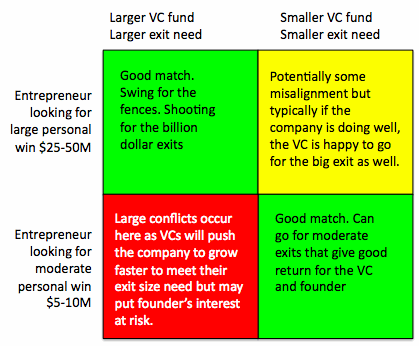Entrepreneur and Investor Alignment
 In this article, Peter Lee, a venture capitalist at Baroda Ventures, an early-stage investment fund in Los Angeles, looks to help entrepreneurs understand the importance of matching different kinds of investors and their goals with their exit outcome expectations. Peter originally posted this piece on his blog, Seeing Eye to Eye.
In this article, Peter Lee, a venture capitalist at Baroda Ventures, an early-stage investment fund in Los Angeles, looks to help entrepreneurs understand the importance of matching different kinds of investors and their goals with their exit outcome expectations. Peter originally posted this piece on his blog, Seeing Eye to Eye.
Having seen many different start-up situations from both the VC side as well as the start-up side, the importance of investor and entrepreneur alignment is often under-estimated in its impact on everyone involved.
For inexperienced entrepreneurs, this issue is not well understood and often leads to some of the biggest areas of disagreement and tension between the entrepreneur and investor. While there are numerous areas where this can occur, I’m going to focus on one where I find the most tension and misunderstanding of the issues. Exit options, VC fund sizes, VC/entrepreneur alignment, and founders’ outcome (in a future post, I will address some of the other issues such as CEO/Founder replacement, VC fund raising cycles and LP ).
Before diving into this discussion, for those of you that are less familiar with VC fund economics, some background reading may be helpful. The first is more of a VC industry analysis by Fred Wilson of Union Square Ventures and the second dives more specifically into the economics of an example fund by Josh Kopelman of First Round Capital. These issues are well understood by VC’s as that is their industry and reflects directly on their own personal economics as it relates to carried interest in their fund (i.e., think about a sales persons understanding of their own compensation/commission structure and how it affects their own motivations and economics).
So, how do the different fund sizes affect VC and founder alignment? Lets first look at it from the VC side and take 2 examples – a large fund of $400-500M and a smaller fund of $50-100M. If you read the background material and/or already understood VC economics/dynamic, there is a difference between how partners at each of those funds will look at exit sizes that are considered worthwhile/successful/attractive. Much of this really boils down to the amount of time each partner has to sit on boards and work with their companies if they consider themselves active investors. With the number of boards that can reasonably be held by one partner in the 6-8 range, this limits the number of investments he can make, which then dictates the average amount of money he typically needs to put into a particular investment, and ultimately drives the need for the size of exit he needs to make the economics work for the fund and himself. In the 2 example fund sizes, obviously larger funds typically need to put in more money (often $10-15M per company) and thereby requiring large exits (in the multiple hundreds of millions per company minimum) vs a smaller fund (often $2-5M per company and with exits in the sub-$100M range reasonable from a fund and personal return perspective). The constant here is that both investors have the same amount of time and bandwidth and will typically do the same number of investments per fund. For an entrepreneur, it is fairly straightforward to see the differences between the 2 types of funds just based on fund size and number of investing partners.
Now lets take a look at it from the founder/entrepreneur’s perspective where there is also a wide range of “personal economics” that matter. To simplify, I’ll just use 2 examples – an entrepreneur who is looking for a large personal exit (one that will make him $25-50M ) and an entrepreneur who is looking for a moderate personal exit (one that will make him $5-10M). Often this is largely based on their personal economic situation at the time (i.e., an already successful entrepreneur who has had his first good exit and put away $5-10M in the bank vs the entrepreneur who maybe has seen modest success with less than $1-2M put away).
Given these two perspectives (VC vs entrepreneur) and the different fund sizes and entrepreneur exit size preferences, this is where investor and entrepreneur alignment becomes critically important in “Seeing Eye To Eye.” Putting my consulting hat on and analyzing this using a 2×2 matrix…

In the matrix, the green represents good alignment, the yellow represents ok but keep watch, and the red represents where I see some of the larger disagreements. The matrix explains the basic situation for all 4 combinations so I’ll just focus on the yellow and red areas as the green areas are fairly self-explanatory and straightforward.
Yellow – Smaller VC fund, Smaller exit need, Entrepreneur looking for large personal win $25-50M. While there is some misalignment here, this is actually a less common situation and often doesn’t become an issue in practice. The reasons are that many entrepreneurs looking for big exits often have already had one hit and have plenty of personal funds. They often use their own money to self-fund the business initially and often don’t need a small amount of outside money but go straight for a much larger Series A from a larger VC. In addition, even for smaller funds who do invest early with these entrepreneurs, if the company is doing very well, those investors are happy to bring in larger VC syndicate partners who have deeper pockets and can fund to a much larger exit. The smaller VC will get a good bump in valuation and is happy to leverage their investment to go for the big exit that the entrepreneur and new VC seek.
Red – Larger VC fund, Larger exit need, Entrepreneur looking for moderate personal win $5-10M. This is where I see the most misalignment, conflicts between VC and entrepreneur, and the primary focus of this post. The conflict occurs in many different situations – whether a company is doing well or not. When companies are doing well, they often have opportunities to exit earlier from incoming acquisition offers. For an entrepreneur who has an opportunity to exit a company at $50M and thereby allowing the entrepreneur to personally make more than $5-10M, this often isn’t big enough to interest the VC who can block the exit and push the company to go for higher exit size (but often a much higher risk to the company). Other areas that this occurs is when determining whether to grow/expand quickly vs getting to profitability. For an entrepreneur to reach his objective, slower growth but getting to profitabilty faster can be the best option, but for the VC, growth over profitability is often the objective thereby require more spend and often leading to more financing rounds diluting the entrepreneur….and these disagreements occur when the company is doing well so generally everyone is happier and want to work together. The misalignment get much more contentious when the company is not doing as well.
Given the varied perspectives of different VCs and entrepreneurs, founders should make sure they understand this dynamic (as the VC will definitely be experienced and understand this well). Ultimately the VC/entrepreneur relationship is a long-term partnership (you may be stuck together for 5+ years). Make sure you go into the relationship understanding each others motivations and goals – it will make for a much more productive and less contentious relationship.
 Tony Greenberg
Tony Greenberg
 Ivan Nikkhoo, Managing Partner – Navigate Ventures
Ivan Nikkhoo, Managing Partner – Navigate Ventures Michael Sherman, Neil Elan and Karine Akopchikyan
Michael Sherman, Neil Elan and Karine Akopchikyan Alejandro Guerrero
Alejandro Guerrero Eric Eide, Alliance for SoCal Innovation
Eric Eide, Alliance for SoCal Innovation Kevin DeBre
Kevin DeBre Braven Greenelsh
Braven Greenelsh Rob Freelen, Los Angeles Market Manager, Silicon Valley Bank
Rob Freelen, Los Angeles Market Manager, Silicon Valley Bank Braven Greenelsh
Braven Greenelsh Kaäre Wagner, Silicon Valley Bank
Kaäre Wagner, Silicon Valley Bank Al Guerrero, Silicon Valley Bank
Al Guerrero, Silicon Valley Bank Rob Freelen, Los Angeles Market Manager, Silicon Valley Bank
Rob Freelen, Los Angeles Market Manager, Silicon Valley Bank Sid Mohasseb
Sid Mohasseb William Hsu
William Hsu Braven Greenelsh
Braven Greenelsh Dinesh Ravishanker
Dinesh Ravishanker Dina Lozosfky
Dina Lozosfky Melinda Moore
Melinda Moore Ivan Nikhoo
Ivan Nikhoo Jaspar Weir
Jaspar Weir Erik Caso
Erik Caso Tracy Olmstead Williams
Tracy Olmstead Williams Dave Berkus
Dave Berkus Bernard Luthi
Bernard Luthi Peter Cowen
Peter Cowen Nick Hedges
Nick Hedges Eric Larsen
Eric Larsen Michael Terpin
Michael Terpin Steve Reich
Steve Reich